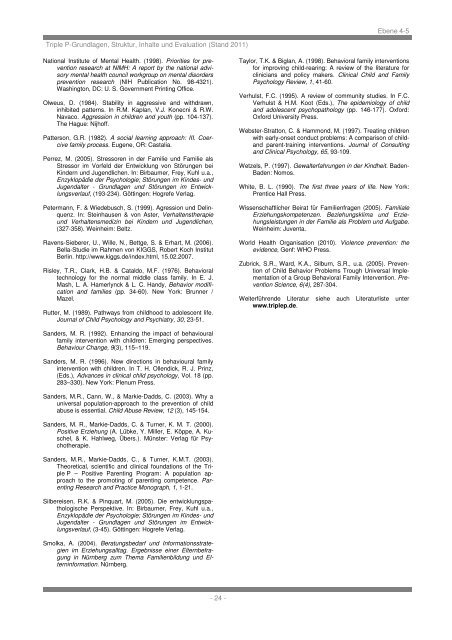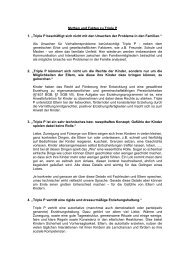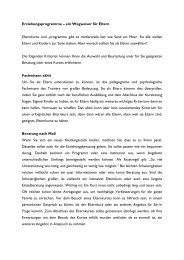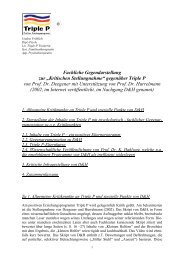Triple P – ein „Public Health“-Ansatz zur Förderung der seelischen ...
Triple P – ein „Public Health“-Ansatz zur Förderung der seelischen ...
Triple P – ein „Public Health“-Ansatz zur Förderung der seelischen ...
Sie wollen auch ein ePaper? Erhöhen Sie die Reichweite Ihrer Titel.
YUMPU macht aus Druck-PDFs automatisch weboptimierte ePaper, die Google liebt.
<strong>Triple</strong> P-Grundlagen, Struktur, Inhalte und Evaluation (Stand 2011)<br />
National Institute of Mental Health. (1998). Priorities for prevention<br />
research at NIMH: A report by the national advisory<br />
mental health council workgroup on mental disor<strong>der</strong>s<br />
prevention research (NIH Publication No. 98-4321).<br />
Washington, DC: U. S. Government Printing Office.<br />
Olweus, D. (1984). Stability in aggressive and withdrawn,<br />
inhibited patterns. In R.M. Kaplan, V.J. Konecni & R.W.<br />
Navaco. Aggression in children and youth (pp. 104-137).<br />
The Hague: Nijhoff.<br />
Patterson, G.R. (1982). A social learning approach: III. Coercive<br />
family process. Eugene, OR: Castalia.<br />
Perrez, M. (2005). Stressoren in <strong>der</strong> Familie und Familie als<br />
Stressor im Vorfeld <strong>der</strong> Entwicklung von Störungen bei<br />
Kin<strong>der</strong>n und Jugendlichen. In: Birbaumer, Frey, Kuhl u.a.,<br />
Enzyklopädie <strong>der</strong> Psychologie; Störungen im Kindes- und<br />
Jugendalter - Grundlagen und Störungen im Entwicklungsverlauf,<br />
(193-234). Göttingen: Hogrefe Verlag.<br />
Petermann, F. & Wiedebusch, S. (1999). Agression und Delinquenz.<br />
In: St<strong>ein</strong>hausen & von Aster, Verhaltenstherapie<br />
und Verhaltensmedizin bei Kin<strong>der</strong>n und Jugendlichen,<br />
(327-358). W<strong>ein</strong>heim: Beltz.<br />
Ravens-Sieberer, U., Wille, N., Bettge, S. & Erhart, M. (2006).<br />
Bella-Studie im Rahmen von KIGGS, Robert Koch Institut<br />
Berlin. http://www.kiggs.de/index.html, 15.02.2007.<br />
Risley, T.R., Clark, H.B. & Cataldo, M.F. (1976). Behavioral<br />
technology for the normal middle class family. In E. J.<br />
Mash, L. A. Hamerlynck & L. C. Handy, Behavior modification<br />
and families (pp. 34-60). New York: Brunner /<br />
Mazel.<br />
Rutter, M. (1989). Pathways from childhood to adolescent life.<br />
Journal of Child Psychology and Psychiatry, 30, 23-51.<br />
San<strong>der</strong>s, M. R. (1992). Enhancing the impact of behavioural<br />
family intervention with children: Emerging perspectives.<br />
Behaviour Change, 9(3), 115<strong>–</strong>119.<br />
San<strong>der</strong>s, M. R. (1996). New directions in behavioural family<br />
intervention with children. In T. H. Ollendick, R. J. Prinz,<br />
(Eds.), Advances in clinical child psychology, Vol. 18 (pp.<br />
283<strong>–</strong>330). New York: Plenum Press.<br />
San<strong>der</strong>s, M.R., Cann, W., & Markie-Dadds, C. (2003). Why a<br />
universal population-approach to the prevention of child<br />
abuse is essential. Child Abuse Review, 12 (3), 145-154.<br />
San<strong>der</strong>s, M. R., Markie-Dadds, C. & Turner, K. M. T. (2000).<br />
Positive Erziehung (A. Lübke, Y. Miller, E. Köppe, A. Kuschel,<br />
& K. Hahlweg, Übers.). Münster: Verlag für Psychotherapie.<br />
San<strong>der</strong>s, M.R., Markie-Dadds, C., & Turner, K.M.T. (2003).<br />
Theoretical, scientific and clinical foundations of the <strong>Triple</strong><br />
P <strong>–</strong> Positive Parenting Program: A population approach<br />
to the promoting of parenting competence. Parenting<br />
Research and Practice Monograph, 1, 1-21.<br />
Silbereisen, R.K. & Pinquart, M. (2005). Die entwicklungspathologische<br />
Perspektive. In: Birbaumer, Frey, Kuhl u.a.,<br />
Enzyklopädie <strong>der</strong> Psychologie; Störungen im Kindes- und<br />
Jugendalter - Grundlagen und Störungen im Entwicklungsverlauf,<br />
(3-45). Göttingen: Hogrefe Verlag.<br />
Smolka, A. (2004). Beratungsbedarf und Informationsstrategien<br />
im Erziehungsalltag. Ergebnisse <strong>ein</strong>er Elternbefragung<br />
in Nürnberg zum Thema Familienbildung und Elterninformation.<br />
Nürnberg.<br />
- 24 -<br />
Ebene 4-5<br />
Taylor, T.K. & Biglan, A. (1998). Behavioral family interventions<br />
for improving child-rearing: A review of the literature for<br />
clinicians and policy makers. Clinical Child and Family<br />
Psychology Review, 1, 41-60.<br />
Verhulst, F.C. (1995). A review of community studies. In F.C.<br />
Verhulst & H.M. Koot (Eds.), The epidemiology of child<br />
and adolescent psychopathology (pp. 146-177). Oxford:<br />
Oxford University Press.<br />
Webster-Stratton, C. & Hammond, M. (1997). Treating children<br />
with early-onset conduct problems: A comparison of child-<br />
and parent-training interventions. Journal of Consulting<br />
and Clinical Psychology, 65, 93-109.<br />
Wetzels, P. (1997). Gewalterfahrungen in <strong>der</strong> Kindheit. Baden-<br />
Baden: Nomos.<br />
White, B. L. (1990). The first three years of life. New York:<br />
Prentice Hall Press.<br />
Wissenschaftlicher Beirat für Familienfragen (2005). Familiale<br />
Erziehungskompetenzen. Beziehungsklima und Erziehungsleistungen<br />
in <strong>der</strong> Familie als Problem und Aufgabe.<br />
W<strong>ein</strong>heim: Juventa.<br />
World Health Organisation (2010). Violence prevention: the<br />
evidence, Genf: WHO Press.<br />
Zubrick, S.R., Ward, K.A., Silburn, S.R., u.a. (2005). Prevention<br />
of Child Behavior Problems Trough Universal Implementation<br />
of a Group Behavioral Family Intervention. Prevention<br />
Science, 6(4), 287-304.<br />
Weiterführende Literatur siehe auch Literaturliste unter<br />
www.triplep.de.









